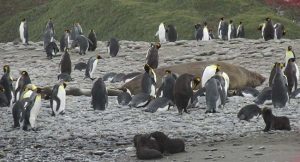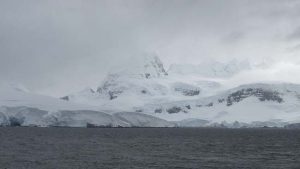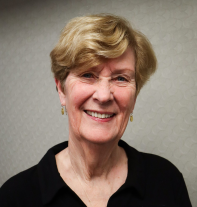The Most Amazing Trip!
The Most Amazing Trip!
Or, “Where I Went On My Winter Vacation.”
By Clive Connor, Secretary, The Scudder Association Foundation.
Bucket list item – check!
In January 2024, I took a trip to the bottom of the world after earlier taking one to the top!
After visiting the Arctic and Greenland in 2015 where I saw polar bears and other wildlife, icebergs, and glaciers, I dreamed about going to Antarctica, South Georgia, and the Falkland Islands to see penguins and different kinds of wildlife and to set foot on my seventh continent.
My three-week, 4,000 mile trip was aboard an expedition ship with 120 other adventurous passengers. We were led by knowledgeable and experienced guides. We left Patagonia, Argentina, and headed to the Falklands. After two days at sea, we arrived there and met our first group of penguins, albatrosses, and cormorants. We needed to stay 15 feet away from any animal, but we were able to walk among them and observe their actions. They didn’t even seem to notice us! We saw four different types of penguins (Magellanic, Gentoo, King and Rockhopper), some in large numbers and some with cute chicks. But this was only the beginning! It was summer so there was no ice but lots of green grass and small flowers. It was also relatively warm (40-50\’s) but with an almost constant wind. The Falkland Islands were the only places on this trip which were inhabited, and we enjoyed a visit to Stanley, the capital city, a very British small town.
After another few days at sea, we arrived at South Georgia, known as the \”Serengeti of the Southern Ocean\” because of the large numbers of marine mammals, penguins, and seabirds that call it home for at least part of the year. It is an uninhabited, mountainous island which was known early last century for its whaling and fur seal industries and its connection to Ernest Shackleton, the Polar explorer. Now, the whaling stations are quietly rusting away while the narrow flat and rocky coastlines are being reclaimed by the animals.
 We visited one bay with a half a million King Penguins standing on the beach, intermixed with other types of penguins, thousands of Antarctic Fur Seals, and a handful of huge Elephant Seals. It is hard to describe such a site! There were too many animals to even land and maintain the required space and so we viewed them up close while cruising in Zodiacs.
We visited one bay with a half a million King Penguins standing on the beach, intermixed with other types of penguins, thousands of Antarctic Fur Seals, and a handful of huge Elephant Seals. It is hard to describe such a site! There were too many animals to even land and maintain the required space and so we viewed them up close while cruising in Zodiacs.
 We also saw two more varieties of penguins (Chinstrap and Macaroni)! South Georgia was a mix of green, grass covered hills and snow-covered volcanic mountains with glaciers coming down steep valleys. Icebergs floated at the mouth of the bays.
Moving west, we again spent several days at sea, but we experienced a krill-feeding frenzy around our ship as more than 50 whales, primarily Fins and Humpbacks, surrounded us along with penguins, fur seals, and seabirds as they feasted. We also came upon the largest iceberg in the world (A23a) – the size of Rhode Island – which is making its way east towards South Georgia.
We stopped at Elephant Island, a dismal island north of the Antarctic Peninsula where Shackleton\’s men spent four months huddled under two lifeboats on a tiny beach awaiting rescue, living on penguins and fur seals, and getting fresh water from the nearby glacier. They survived. Our trip was \”The Spirit of Shackleton\” and we were thankful for our warm ship and good food!
From there, we traveled to the South Shetland Islands, opposite the tip of the Antarctic Peninsula, and went into the caldera of Deception Island. The remains of an old whaling station and later, a research station, were there. The volcano\’s last eruption was in 1969. The black sides of the caldera, lightly dusted with snow, along with gray skies, gave the sense of being in a black and white world! Even the Chinstrap Penguins were black and white! Only our ship gave us a pop of color against this backdrop! It was also surreal that with snow on the upper part of the black sand beach, one could push one\’s boots into the sand down near the water\’s edge and have them warmed by hot water! The beach was literally steaming!
We also saw two more varieties of penguins (Chinstrap and Macaroni)! South Georgia was a mix of green, grass covered hills and snow-covered volcanic mountains with glaciers coming down steep valleys. Icebergs floated at the mouth of the bays.
Moving west, we again spent several days at sea, but we experienced a krill-feeding frenzy around our ship as more than 50 whales, primarily Fins and Humpbacks, surrounded us along with penguins, fur seals, and seabirds as they feasted. We also came upon the largest iceberg in the world (A23a) – the size of Rhode Island – which is making its way east towards South Georgia.
We stopped at Elephant Island, a dismal island north of the Antarctic Peninsula where Shackleton\’s men spent four months huddled under two lifeboats on a tiny beach awaiting rescue, living on penguins and fur seals, and getting fresh water from the nearby glacier. They survived. Our trip was \”The Spirit of Shackleton\” and we were thankful for our warm ship and good food!
From there, we traveled to the South Shetland Islands, opposite the tip of the Antarctic Peninsula, and went into the caldera of Deception Island. The remains of an old whaling station and later, a research station, were there. The volcano\’s last eruption was in 1969. The black sides of the caldera, lightly dusted with snow, along with gray skies, gave the sense of being in a black and white world! Even the Chinstrap Penguins were black and white! Only our ship gave us a pop of color against this backdrop! It was also surreal that with snow on the upper part of the black sand beach, one could push one\’s boots into the sand down near the water\’s edge and have them warmed by hot water! The beach was literally steaming!
 That afternoon, we finally reached the Antarctic Peninsula, an outstretched finger of the continent. Only researchers and crews get to travel to deep into the continent itself. The rest of us must be content with the Peninsula but what a place to be! Deep snow and ice, bare patches of rock, icebergs and sea ice, mountains rising straight up from the water, and wildlife. The numbers were smaller than in South Georgia but still very diverse.
That afternoon, we finally reached the Antarctic Peninsula, an outstretched finger of the continent. Only researchers and crews get to travel to deep into the continent itself. The rest of us must be content with the Peninsula but what a place to be! Deep snow and ice, bare patches of rock, icebergs and sea ice, mountains rising straight up from the water, and wildlife. The numbers were smaller than in South Georgia but still very diverse.
 I saw Gentoo and Chinstrap Penguins again but also a new one – the Adelie. I saw Weddell Seals, Leopard Seals, and Antarctic Fur Seals. The latter are actually a type of eared Sea Lion and not \”true\” seals. Again, there were many seabirds. We saw Humpback whales every day and even saw one whale harassing a group of small Orcas that were making their home down there. It was the height of summer in January, so the temperatures were hovering just above and below freezing but with the occasional snowstorm and hailstorm, not to mention the ever present 30 mph or more wind! Antarctica is the driest and windiest place on earth! The only plant life we saw were some mosses and lichens on rocks and red and green algae growing on the ice. The bottoms of sea ice are supposedly covered with algae as well.
We must protect and preserve these areas and the wildlife for future generations. There are ever increasing threats. Avian Flu reached South Georgia and Antarctica this year through the vector of seabirds. Penguins and seabirds are obviously vulnerable, but the Flu also kills seals and fur seals. As visitors, we performed bio-security checks and routine disinfection of our boots to prevent the spread. Other than that, there is not much we can do about the flu except hope that the sheer numbers of animals will ensure the continuation of the populations.
However, there are two other threats on which we could have an effect. They are climate changes due to global warming and the reduction of food sources. The sea temperatures in the Southern Ocean are rising quickly, resulting in the loss of sea ice in the summer months. Sea ice is critical for the survival of the young krill during the winter months, providing food from the algae and protection from predators. All of the animals here rely on krill in their diet. Adult krill stocks are being depleted by illegal overfishing. It is difficult to monitor krill fishing in the Southern Ocean and the krill is being taken in huge quantities to end up as animal feed, cosmetics, fish paste for human consumption, and in krill oil supplements. If we reduce our demand for these goods, the depletion of krill would also be reduced. In addition, we need to continue to look for ways to reduce our personal carbon output to reduce global warming.
These individual actions can help make a difference in protecting these amazing animals and their environments.
I saw Gentoo and Chinstrap Penguins again but also a new one – the Adelie. I saw Weddell Seals, Leopard Seals, and Antarctic Fur Seals. The latter are actually a type of eared Sea Lion and not \”true\” seals. Again, there were many seabirds. We saw Humpback whales every day and even saw one whale harassing a group of small Orcas that were making their home down there. It was the height of summer in January, so the temperatures were hovering just above and below freezing but with the occasional snowstorm and hailstorm, not to mention the ever present 30 mph or more wind! Antarctica is the driest and windiest place on earth! The only plant life we saw were some mosses and lichens on rocks and red and green algae growing on the ice. The bottoms of sea ice are supposedly covered with algae as well.
We must protect and preserve these areas and the wildlife for future generations. There are ever increasing threats. Avian Flu reached South Georgia and Antarctica this year through the vector of seabirds. Penguins and seabirds are obviously vulnerable, but the Flu also kills seals and fur seals. As visitors, we performed bio-security checks and routine disinfection of our boots to prevent the spread. Other than that, there is not much we can do about the flu except hope that the sheer numbers of animals will ensure the continuation of the populations.
However, there are two other threats on which we could have an effect. They are climate changes due to global warming and the reduction of food sources. The sea temperatures in the Southern Ocean are rising quickly, resulting in the loss of sea ice in the summer months. Sea ice is critical for the survival of the young krill during the winter months, providing food from the algae and protection from predators. All of the animals here rely on krill in their diet. Adult krill stocks are being depleted by illegal overfishing. It is difficult to monitor krill fishing in the Southern Ocean and the krill is being taken in huge quantities to end up as animal feed, cosmetics, fish paste for human consumption, and in krill oil supplements. If we reduce our demand for these goods, the depletion of krill would also be reduced. In addition, we need to continue to look for ways to reduce our personal carbon output to reduce global warming.
These individual actions can help make a difference in protecting these amazing animals and their environments.
 We visited one bay with a half a million King Penguins standing on the beach, intermixed with other types of penguins, thousands of Antarctic Fur Seals, and a handful of huge Elephant Seals. It is hard to describe such a site! There were too many animals to even land and maintain the required space and so we viewed them up close while cruising in Zodiacs.
We visited one bay with a half a million King Penguins standing on the beach, intermixed with other types of penguins, thousands of Antarctic Fur Seals, and a handful of huge Elephant Seals. It is hard to describe such a site! There were too many animals to even land and maintain the required space and so we viewed them up close while cruising in Zodiacs.
 We also saw two more varieties of penguins (Chinstrap and Macaroni)! South Georgia was a mix of green, grass covered hills and snow-covered volcanic mountains with glaciers coming down steep valleys. Icebergs floated at the mouth of the bays.
Moving west, we again spent several days at sea, but we experienced a krill-feeding frenzy around our ship as more than 50 whales, primarily Fins and Humpbacks, surrounded us along with penguins, fur seals, and seabirds as they feasted. We also came upon the largest iceberg in the world (A23a) – the size of Rhode Island – which is making its way east towards South Georgia.
We stopped at Elephant Island, a dismal island north of the Antarctic Peninsula where Shackleton\’s men spent four months huddled under two lifeboats on a tiny beach awaiting rescue, living on penguins and fur seals, and getting fresh water from the nearby glacier. They survived. Our trip was \”The Spirit of Shackleton\” and we were thankful for our warm ship and good food!
From there, we traveled to the South Shetland Islands, opposite the tip of the Antarctic Peninsula, and went into the caldera of Deception Island. The remains of an old whaling station and later, a research station, were there. The volcano\’s last eruption was in 1969. The black sides of the caldera, lightly dusted with snow, along with gray skies, gave the sense of being in a black and white world! Even the Chinstrap Penguins were black and white! Only our ship gave us a pop of color against this backdrop! It was also surreal that with snow on the upper part of the black sand beach, one could push one\’s boots into the sand down near the water\’s edge and have them warmed by hot water! The beach was literally steaming!
We also saw two more varieties of penguins (Chinstrap and Macaroni)! South Georgia was a mix of green, grass covered hills and snow-covered volcanic mountains with glaciers coming down steep valleys. Icebergs floated at the mouth of the bays.
Moving west, we again spent several days at sea, but we experienced a krill-feeding frenzy around our ship as more than 50 whales, primarily Fins and Humpbacks, surrounded us along with penguins, fur seals, and seabirds as they feasted. We also came upon the largest iceberg in the world (A23a) – the size of Rhode Island – which is making its way east towards South Georgia.
We stopped at Elephant Island, a dismal island north of the Antarctic Peninsula where Shackleton\’s men spent four months huddled under two lifeboats on a tiny beach awaiting rescue, living on penguins and fur seals, and getting fresh water from the nearby glacier. They survived. Our trip was \”The Spirit of Shackleton\” and we were thankful for our warm ship and good food!
From there, we traveled to the South Shetland Islands, opposite the tip of the Antarctic Peninsula, and went into the caldera of Deception Island. The remains of an old whaling station and later, a research station, were there. The volcano\’s last eruption was in 1969. The black sides of the caldera, lightly dusted with snow, along with gray skies, gave the sense of being in a black and white world! Even the Chinstrap Penguins were black and white! Only our ship gave us a pop of color against this backdrop! It was also surreal that with snow on the upper part of the black sand beach, one could push one\’s boots into the sand down near the water\’s edge and have them warmed by hot water! The beach was literally steaming!
 That afternoon, we finally reached the Antarctic Peninsula, an outstretched finger of the continent. Only researchers and crews get to travel to deep into the continent itself. The rest of us must be content with the Peninsula but what a place to be! Deep snow and ice, bare patches of rock, icebergs and sea ice, mountains rising straight up from the water, and wildlife. The numbers were smaller than in South Georgia but still very diverse.
That afternoon, we finally reached the Antarctic Peninsula, an outstretched finger of the continent. Only researchers and crews get to travel to deep into the continent itself. The rest of us must be content with the Peninsula but what a place to be! Deep snow and ice, bare patches of rock, icebergs and sea ice, mountains rising straight up from the water, and wildlife. The numbers were smaller than in South Georgia but still very diverse.
 I saw Gentoo and Chinstrap Penguins again but also a new one – the Adelie. I saw Weddell Seals, Leopard Seals, and Antarctic Fur Seals. The latter are actually a type of eared Sea Lion and not \”true\” seals. Again, there were many seabirds. We saw Humpback whales every day and even saw one whale harassing a group of small Orcas that were making their home down there. It was the height of summer in January, so the temperatures were hovering just above and below freezing but with the occasional snowstorm and hailstorm, not to mention the ever present 30 mph or more wind! Antarctica is the driest and windiest place on earth! The only plant life we saw were some mosses and lichens on rocks and red and green algae growing on the ice. The bottoms of sea ice are supposedly covered with algae as well.
We must protect and preserve these areas and the wildlife for future generations. There are ever increasing threats. Avian Flu reached South Georgia and Antarctica this year through the vector of seabirds. Penguins and seabirds are obviously vulnerable, but the Flu also kills seals and fur seals. As visitors, we performed bio-security checks and routine disinfection of our boots to prevent the spread. Other than that, there is not much we can do about the flu except hope that the sheer numbers of animals will ensure the continuation of the populations.
However, there are two other threats on which we could have an effect. They are climate changes due to global warming and the reduction of food sources. The sea temperatures in the Southern Ocean are rising quickly, resulting in the loss of sea ice in the summer months. Sea ice is critical for the survival of the young krill during the winter months, providing food from the algae and protection from predators. All of the animals here rely on krill in their diet. Adult krill stocks are being depleted by illegal overfishing. It is difficult to monitor krill fishing in the Southern Ocean and the krill is being taken in huge quantities to end up as animal feed, cosmetics, fish paste for human consumption, and in krill oil supplements. If we reduce our demand for these goods, the depletion of krill would also be reduced. In addition, we need to continue to look for ways to reduce our personal carbon output to reduce global warming.
These individual actions can help make a difference in protecting these amazing animals and their environments.
I saw Gentoo and Chinstrap Penguins again but also a new one – the Adelie. I saw Weddell Seals, Leopard Seals, and Antarctic Fur Seals. The latter are actually a type of eared Sea Lion and not \”true\” seals. Again, there were many seabirds. We saw Humpback whales every day and even saw one whale harassing a group of small Orcas that were making their home down there. It was the height of summer in January, so the temperatures were hovering just above and below freezing but with the occasional snowstorm and hailstorm, not to mention the ever present 30 mph or more wind! Antarctica is the driest and windiest place on earth! The only plant life we saw were some mosses and lichens on rocks and red and green algae growing on the ice. The bottoms of sea ice are supposedly covered with algae as well.
We must protect and preserve these areas and the wildlife for future generations. There are ever increasing threats. Avian Flu reached South Georgia and Antarctica this year through the vector of seabirds. Penguins and seabirds are obviously vulnerable, but the Flu also kills seals and fur seals. As visitors, we performed bio-security checks and routine disinfection of our boots to prevent the spread. Other than that, there is not much we can do about the flu except hope that the sheer numbers of animals will ensure the continuation of the populations.
However, there are two other threats on which we could have an effect. They are climate changes due to global warming and the reduction of food sources. The sea temperatures in the Southern Ocean are rising quickly, resulting in the loss of sea ice in the summer months. Sea ice is critical for the survival of the young krill during the winter months, providing food from the algae and protection from predators. All of the animals here rely on krill in their diet. Adult krill stocks are being depleted by illegal overfishing. It is difficult to monitor krill fishing in the Southern Ocean and the krill is being taken in huge quantities to end up as animal feed, cosmetics, fish paste for human consumption, and in krill oil supplements. If we reduce our demand for these goods, the depletion of krill would also be reduced. In addition, we need to continue to look for ways to reduce our personal carbon output to reduce global warming.
These individual actions can help make a difference in protecting these amazing animals and their environments. 

